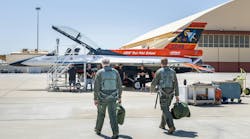Participants in ARSA’s Oct. 18 training session “FAA Form 8130-3 – Completion Instructions & Multiple Releases,” heard about my love of forms. Paperwork is the one enjoyable part of going to the doctor or dentist or scheduling other appointments. Particularly thanks to the easy reference of the internet available through a mobile device, filling out a form is like taking a test for which you know (or can quickly find) all the answers. It’s satisfying.
That’s the right lesson for aviation safety, where each form must be carefully understood in all record-making and keeping actions. Aviation professionals must know how to collect, transfer, and store knowledge. ARSA helps its members by making generic instructions for completing government documents part of its free “tools,” which help repair stations and applicants in constructing procedures supporting their own creation of records.
This isn’t just a repair station issue, of course. Many requirements of 14 CFR are tied to paperwork. Overfocusing on documentation can be a problem – ARSA believes it’s a root cause of the trepidation surrounding questionable part sales practices by AOG Technics – but putting pen to paper (or bytes to digital storage) is undeniably a key element of compliance.
Specific to the 8130, no document holds a more central – and fraught – place in the aviation maintenance world. In an earlier training session, I laid the groundwork for current use of the form by walking through its history; it was first issued by the FAA for export only to establish compliance with an importing country’s requirements. Under international efforts, the form underwent considerable revision in the 1990s to harmonize it “more closely with the form used for comparable purposes in other countries.” The FAA also noted the expansion of the form’s use to include approving work on articles for return to service: “Many countries have indicated to the FAA that an FAA Form 8130-3 form [sic] on a used product, filled out for return to service, will be acceptable documentation rather than requiring the tag to be filled out as an export airworthiness approval.”
Allowing the form’s use for return to service does not mandate it, nor does it guarantee compliance with the rules. In addition to the specifics provided through ARSA’s instructions document, participants in the “8130-3 Completion” session heard discussion of the form’s overall purpose and careful consideration of its use for international releases. Some key points:
- Under U.S. rules, an FAA Form 8130-3 need not be used to issue an approval for return to service (to quote Sarah MacLeod, a repair station can keep its records on toilet paper if it elects to in its manual system).
- When used, the form will be completed by a U.S. repair station only after the final inspection required by § 145.213 has been accomplished; it is issued as a maintenance release in compliance with §§ 43.9(a)(1), (2) and (4).
- To comply with § 43.9(a)(3) the repair station’s work package needs to include the names of all persons (including contractors) that performed work other than the repair station approving the entire work scope for return to service.
- To issue the form for release in the jurisdiction of multiple civil aviation authorities, ensure the language in Block 12 covers the current regulatory requirements stipulated for each CAA, either through the implementation procedures associated with a bilateral agreement or the importing requirements/aviation safety rules of the country.
The “magic form” training series is now available for on-demand viewing and provides opportunity to hear this in-depth presentation and discussion. Paired with good written instructions (like those provided by ARSA), it allows repair stations to go beyond simple form completion and ensure personnel fully understand how to use the form to show compliance.
We can’t make anyone love completing a form, but it sure can help maintenance providers pass each form’s test.
Brett Levanto is vice president of operations of Obadal, Filler, MacLeod & Klein, P.L.C. managing firm and client communications in conjunction with regulatory and legislative policy initiatives. He provides strategic and logistical support for the Aeronautical Repair Station Association.

